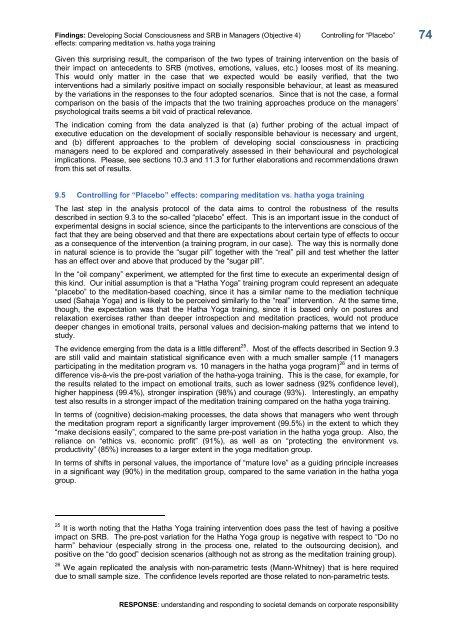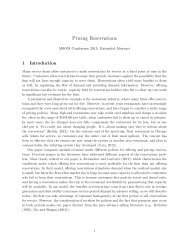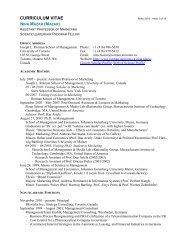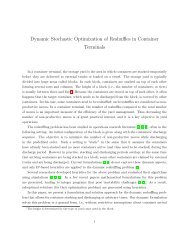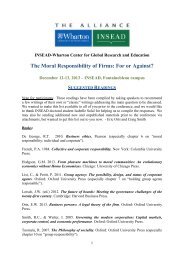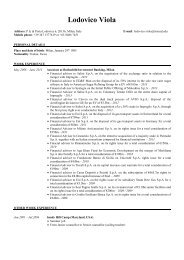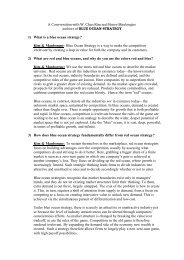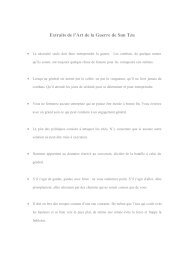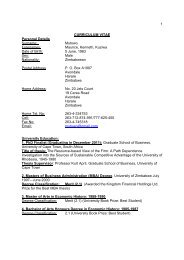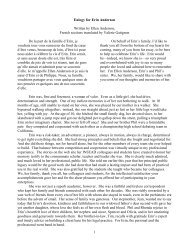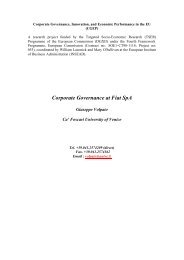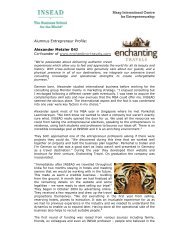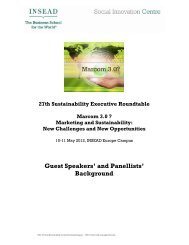RESPONSE - Insead
RESPONSE - Insead
RESPONSE - Insead
You also want an ePaper? Increase the reach of your titles
YUMPU automatically turns print PDFs into web optimized ePapers that Google loves.
Findings: Developing Social Consciousness and SRB in Managers (Objective 4) Controlling for “Placebo”<br />
effects: comparing meditation vs. hatha yoga training<br />
Given this surprising result, the comparison of the two types of training intervention on the basis of<br />
their impact on antecedents to SRB (motives, emotions, values, etc.) looses most of its meaning.<br />
This would only matter in the case that we expected would be easily verified, that the two<br />
interventions had a similarly positive impact on socially responsible behaviour, at least as measured<br />
by the variations in the responses to the four adopted scenarios. Since that is not the case, a formal<br />
comparison on the basis of the impacts that the two training approaches produce on the managers’<br />
psychological traits seems a bit void of practical relevance.<br />
The indication coming from the data analyzed is that (a) further probing of the actual impact of<br />
executive education on the development of socially responsible behaviour is necessary and urgent,<br />
and (b) different approaches to the problem of developing social consciousness in practicing<br />
managers need to be explored and comparatively assessed in their behavioural and psychological<br />
implications. Please, see sections 10.3 and 11.3 for further elaborations and recommendations drawn<br />
from this set of results.<br />
9.5 Controlling for “Placebo” effects: comparing meditation vs. hatha yoga training<br />
The last step in the analysis protocol of the data aims to control the robustness of the results<br />
described in section 9.3 to the socalled “placebo” effect. This is an important issue in the conduct of<br />
experimental designs in social science, since the participants to the interventions are conscious of the<br />
fact that they are being observed and that there are expectations about certain type of effects to occur<br />
as a consequence of the intervention (a training program, in our case). The way this is normally done<br />
in natural science is to provide the “sugar pill” together with the “real” pill and test whether the latter<br />
has an effect over and above that produced by the “sugar pill”.<br />
In the “oil company” experiment, we attempted for the first time to execute an experimental design of<br />
this kind. Our initial assumption is that a “Hatha Yoga” training program could represent an adequate<br />
“placebo” to the meditationbased coaching, since it has a similar name to the mediation technique<br />
used (Sahaja Yoga) and is likely to be perceived similarly to the “real” intervention. At the same time,<br />
though, the expectation was that the Hatha Yoga training, since it is based only on postures and<br />
relaxation exercises rather than deeper introspection and meditation practices, would not produce<br />
deeper changes in emotional traits, personal values and decisionmaking patterns that we intend to<br />
study.<br />
The evidence emerging from the data is a little different 25 . Most of the effects described in Section 9.3<br />
are still valid and maintain statistical significance even with a much smaller sample (11 managers<br />
participating in the meditation program vs. 10 managers in the hatha yoga program) 26 and in terms of<br />
difference visàvis the prepost variation of the hathayoga training. This is the case, for example, for<br />
the results related to the impact on emotional traits, such as lower sadness (92% confidence level),<br />
higher happiness (99.4%), stronger inspiration (98%) and courage (93%). Interestingly, an empathy<br />
test also results in a stronger impact of the meditation training compared on the hatha yoga training.<br />
In terms of (cognitive) decisionmaking processes, the data shows that managers who went through<br />
the meditation program report a significantly larger improvement (99.5%) in the extent to which they<br />
“make decisions easily”, compared to the same prepost variation in the hatha yoga group. Also, the<br />
reliance on “ethics vs. economic profit” (91%), as well as on “protecting the environment vs.<br />
productivity” (85%) increases to a larger extent in the yoga meditation group.<br />
In terms of shifts in personal values, the importance of “mature love” as a guiding principle increases<br />
in a significant way (90%) in the meditation group, compared to the same variation in the hatha yoga<br />
group.<br />
25 It is worth noting that the Hatha Yoga training intervention does pass the test of having a positive<br />
impact on SRB. The prepost variation for the Hatha Yoga group is negative with respect to “Do no<br />
harm” behaviour (especially strong in the process one, related to the outsourcing decision), and<br />
positive on the “do good” decision scenarios (although not as strong as the meditation training group).<br />
26 We again replicated the analysis with nonparametric tests (MannWhitney) that is here required<br />
due to small sample size. The confidence levels reported are those related to nonparametric tests.<br />
<strong>RESPONSE</strong>: understanding and responding to societal demands on corporate responsibility<br />
74


